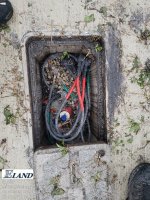Cjmccarthy
Member
- Location
- Florida
- Occupation
- Project Coordinator FDOT
I work for the FDOT, and we are doing a walkthrough of a project that was completed. The project is an ITS project. The power service goes to a generator site that has an Automatic transfer switch for backup power. From there it goes underground in a 2inch HDPE conduit, and we are using Quazite Pull Boxes (Concrete blend). The 2 conductors are carrying 600v along with a green ground conductor to each site. The runs are long, and the contractor must splice the conductors together in some of the pull boxes. On every other project, the contractor installed a ground rod in the pull box where a splice was present and Exothermic Welded the ground conductors to the ground rod. On the latest project, they are fighting that and saying, "Where in the FDOT spec does it say we have to do that!". The FDOT references the NEC, NESC and many other agencies for references outside their spec. My question is, is there a code I can hold them to in either the NEC or NESC?
Thank you, Chris
Thank you, Chris


